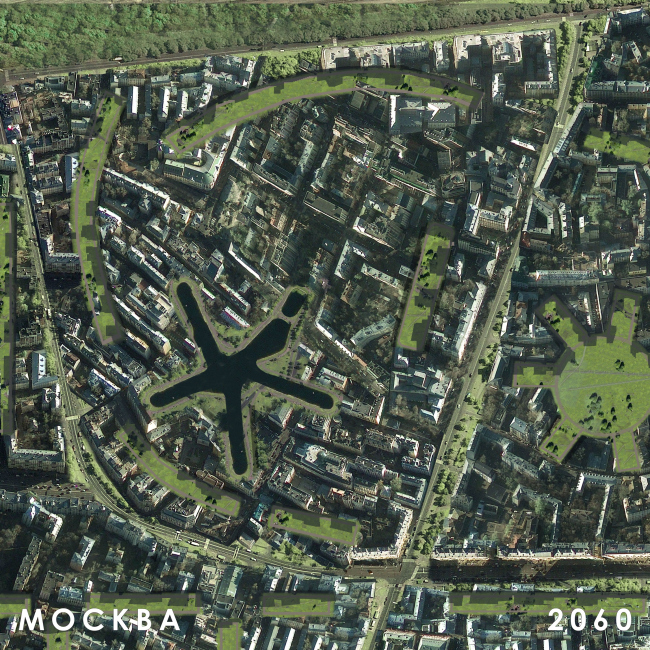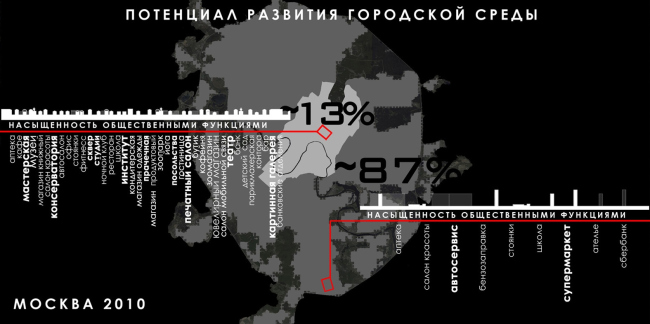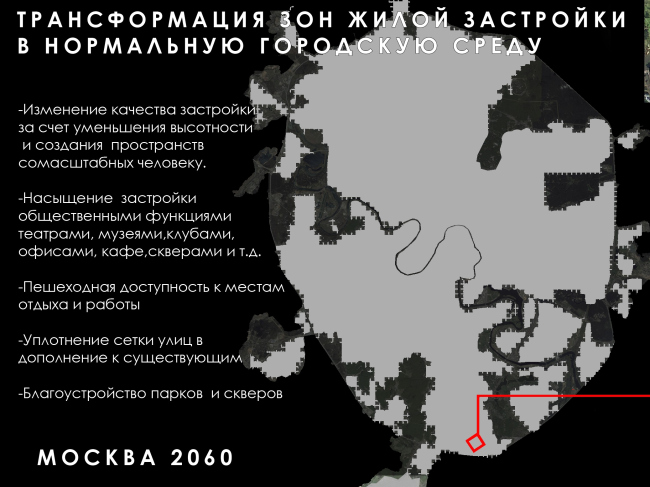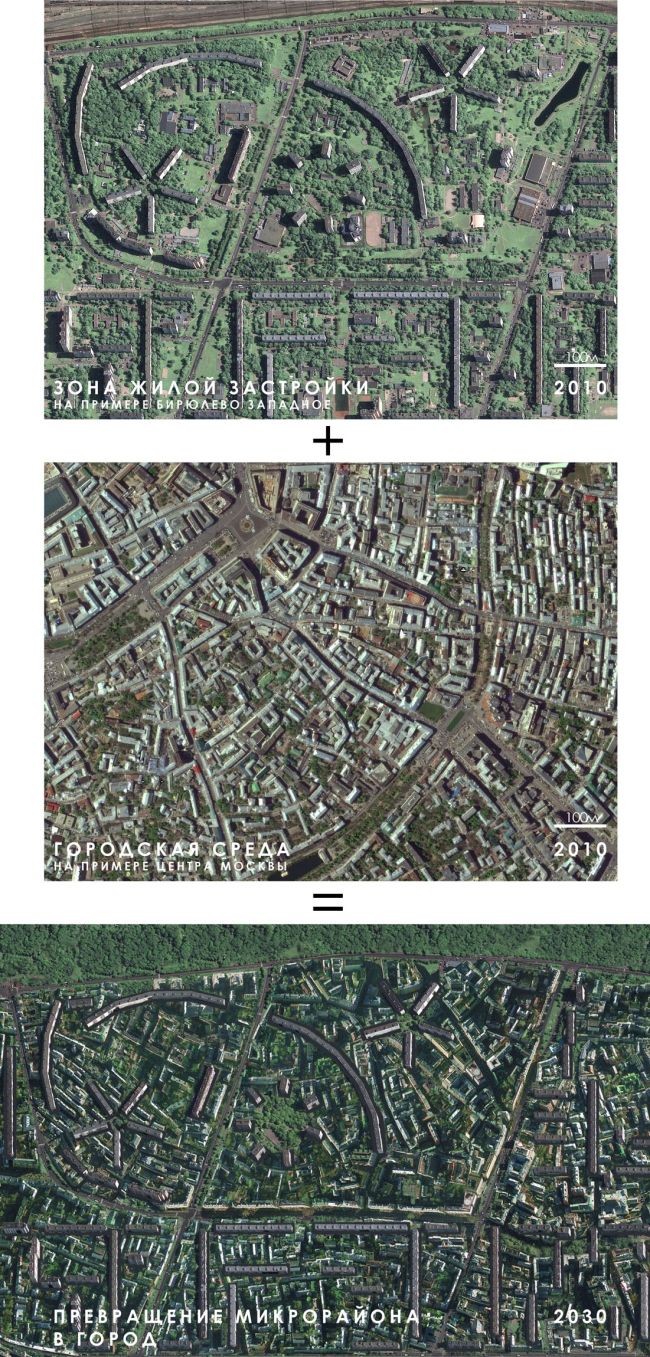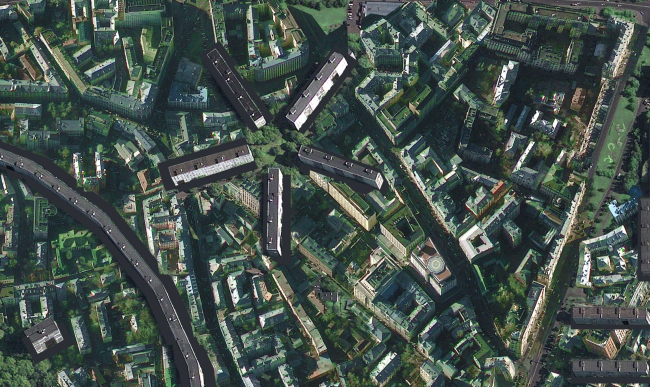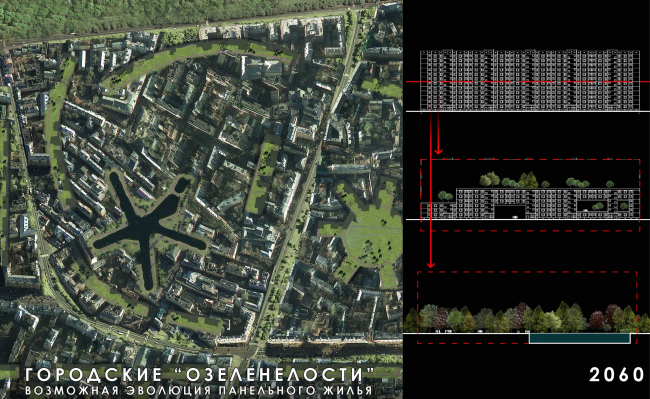|
Published on Archi.ru (https://archi.ru) |
|
| 03.12.2013 | |
|
Urban Evolution |
|
|
Anna Martovitskaya |
|
| Architect: | |
| Daniel Lorenz | |
| Natalia Sidorova | |
| Konstantin Khodnev | |
| Studio: | |
| DNK Architectural Group | |
|
On the threshold of the Moscow Urban Forum 2013, whose main theme will be the development of the urban periphery, we publish the project "Replacement" by DNK architectural group. Developed back in 2010 as a case study of Moscow's Biryulevo-West neighborhood, today it remains as vital as ever.  "Replacement" project © "DNK Architectural Group" "Replacement" is one of the ten concepts that were showcased in 2010 at Moscow Architectural Biennale as part of the project "The future of the megalopolis. Project Moscow" the curator of which was Elena Gonzales. At this point we will remind you that the mere three years ago the terms "urbanism" and "new town-planning policy" were not half as popular as they are now, and the problem of the commuter belts or "bedroom suburbs" was of little interest to anyone - except maybe the inhabitants of the latter. It was still a year before the moment that the idea of expanding Moscow was ever announced, and the most heated debate was all about approving the Master Plan of Moscow (that is presently being revised). So this was basically the background against which Elena Gonzales initiated her project. The curator asked ten architectural bureaus of the nation's capital but one question: "What will Moscow look like in 40-50-60 years? Present your vision with one picture!" In fact, the participants of the project were to express themselves with some sort of a futuristic canvas of a town-planning nature - but DNK Architectural Group delved deeper into the subject. The team used this task as the occasion to ask themselves a question: what are the main problems with this city and what we would want to change? Change specifically on the structural level. 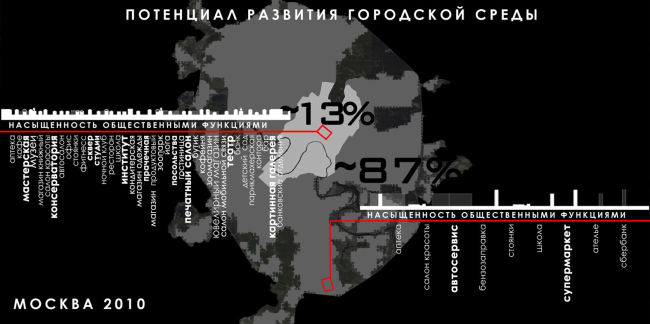 "Replacement" project © "DNK Architectural Group" "Still, in spite of the fact that we significantly pushed the limits of the task that was initially set before us, this is not a scientific or not even strictly "project" work - it is rather a conceptual/artistic project" - explains Natalia Sidorova. It might have been laid to rest in the bureau's portfolios and catalogues forever, had it not been for the fact that the points stipulated in it became, three years later, the basis of the city's new urban planning strategy. "Showcasing "Replacement" is also important for us because, curiously enough, three years ago, as the case example of our project, we chose the district of Biryulevo-West that has recently attracted so much public attention" - adds Konstantin Khodnev. However, while today's focus of publications on Biryulevo has mostly shifted to the pointedly social and politically colored statements, back in the day the architects treated that part of Moscow specifically as the classical case of a "bedroom suburb" - a giant urban formation reigned by gigantic clusters alternating with just as gigantic wastelands. To the architects, it was perfectly clear that, with all its unattractiveness, this district, as well as its numerous analogues, has a huge potential for the quality development of the city, all the more so because of the sheer fact that, as opposed to industrial parks, about the reorganization of which everybody seems to be talking, such bedroom districts are places where people already live, and these people are in need of positive changes. 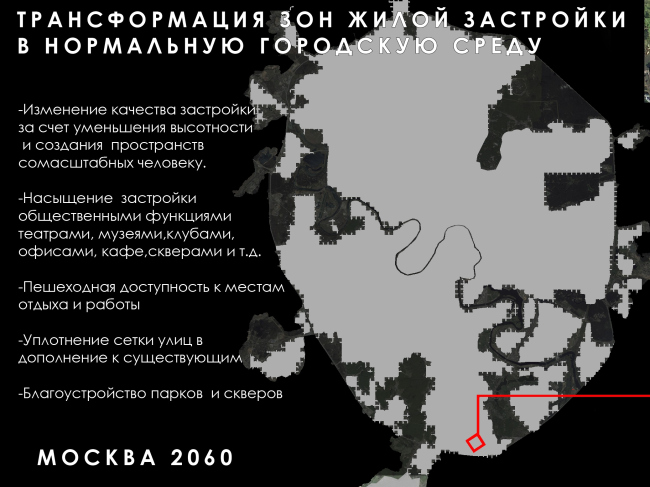 "Replacement" project © "DNK Architectural Group" Deciding not to limit themselves to but one picture, the architects still were able to come up with a single keyword that conveys the essence of the structural changes that they proposed. "Replacement" is an attempt to literally incorporate one fragment of city fabric into another. In this case - a small piece of Moscow downtown as a sample of environment that is better off from the social, as well as from the town-planning standpoint, into Biryulevo-West. "What we did was mix on the same scale the existing "non-human" superstructure of this territory and the town planning of the city center, vividly showing what the commuter belt is missing in order to form a fully-fledged city environment - Daniel Lorenz explains - Our main goal was to smooth out the existing striking difference between the central districts and their peripheral counterparts where the normal urban environment is virtually non-existent".  "Replacement" project © "DNK Architectural Group" The picturesque pattern of winding streets, small and cozy courtyards, pedestrian-only squares, boulevards, and parks - all of this the architects literally superimpose upon the master plan of Biryulevo, thus demonstrating just how poor the existing environment of today's Moscow bedroom suburb is. Even in the spots where the buildings are grouped into some sorts of clusters, so much unused space is left out that even the trees and shrubs are powerless to conceal it. It is clear that it is this social/space vacuum that turns this district into an antithesis of the cozy downtown that is great to live in. And, as far as the trees and shrubs are concerned, the authors of the project think nothing of relocating those, turning them into "urban parks" - meaning creating the necessary conditions for organic coexistence of nature and architecture. 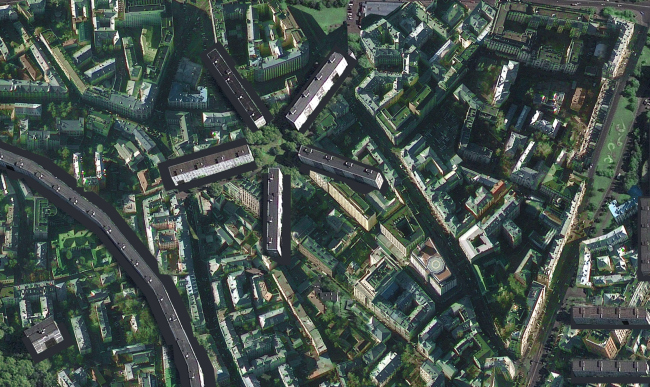 "Replacement" project © "DNK Architectural Group" Besides the landscaped parks, the infrastructure needs to be saturated with clubs, cafes, shops, offices, theaters, and museums - in other words, with social functions and workplaces that also need to have walking access. And as for the main means of humanizing the environment long-term, the architects say that it will be changing the quality of the existing housing infrastructure by means of decreasing the height of the buildings and creating spaces that are human-proportional. Thus, "Replacement" covers not only the master plan of neighborhood, but also its main content, i.e. the pre-fabricated panel housing. In the DNK project, the existing housing infrastructure is first transformed in the more comfortable 5-7 story housing, and then, with time, is taken completely apart to be replaced with parks and creeks that "preserve the memory of the place". For example, on the master plan "Moscow 2060", the "gears" and "arches" that are in actuality formed by the look-alike high-rises, still dominate but in green and blue colors.  "Replacement" project © "DNK Architectural Group" "The project was of strictly conceptual nature, with a huge 50-year planning horizon but what it does is it really sets the real vector of development -say the architects - To make such transformation of bedroom suburbs into a normal city environment become a reality, we should already be thinking through and introducing into the strategic documents of territorial planning a new, denser network of city streets in addition to the existing ones, and to carry out the transformation or "replacement" in a gradual manner, proceeding from the single map of "lifetime" and the condition of the houses and their series". Today that the replacement of one type of city territories with another becomes the key strategy of the development of Moscow (district are replaced by blocks; the roads, wherever possible, are replaced with pedestrian territories, wastelands with parks, etc), the three-year old DNK project is perceived like a self-fulfilling urban prophecy. As for the architects themselves, they think that their project is as vital as ever - ultimately, if not Biryulevo-West, then some other part of "commuter belt" of the nation's capital can be turned, following this scenario, into a piece of fully-fledged city environment. NoneNoneNoneNoneNoneNone |
|
